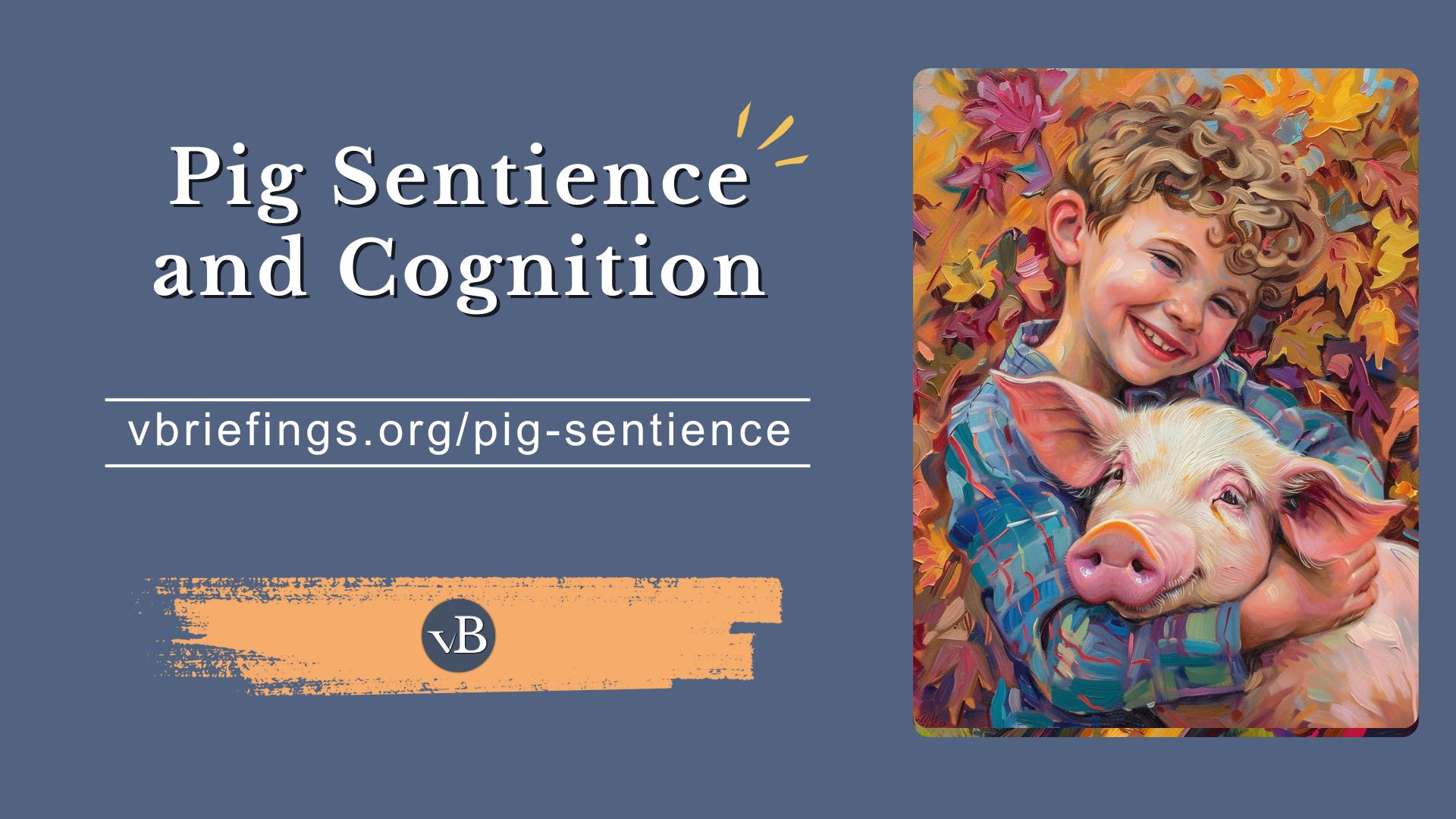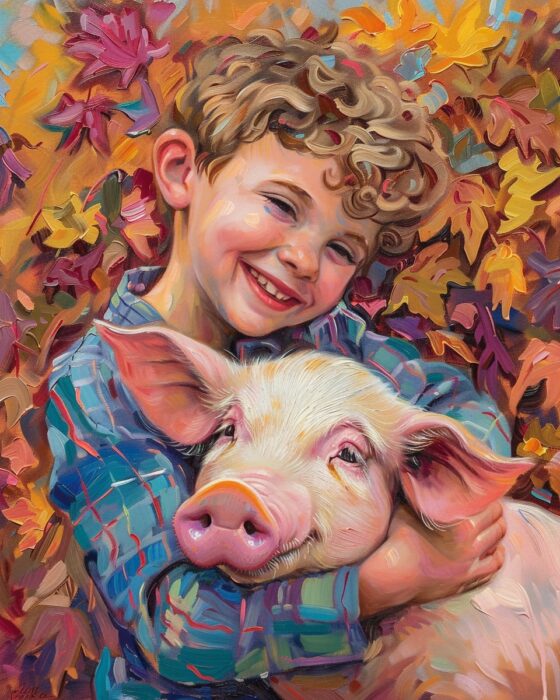Preface
Briefing description and more.
Pigs are sentient, capable of complex mental processes, and lead rich cognitive, emotional, and psychological lives.
Companion Videos
How to use companion videos
Videos may be posted on multiple social media platforms, and you can share them on each platform according each platform’s conventions.
Share this Briefing
Social Media Sharing Image
This image will be used when sharing the briefing on a social media platform. You can see all social sharing images in the grid view.

How to share this briefing
Click on the icon for the platform on which you wish to share. What happens next depends on the platform, but generally a popup will appear, letting you add your own text as you share.
Briefing Meta
Metrics
Note: we will publish additional briefings after completing flashcards and presentation slides for selected briefings.
Counts:
| Main Text | |
| Key Points | 7 |
| Counterclaims | 2 |
| Supplementary | 4 |
| Further Study | 6 |
| Footnotes | 20 |
| Media & Advocacy | |
| Advocacy Notes | 13 |
| —Socratic Questions | 20 |
| Flashcards | 0 |
| Presentation Slides | 0 |
| Memes & Infographics | 0 |
| Companion Videos | 0 |
Other Meta:
Date Posted:
Last Edited:
Edit Log:
Key Points Links
Loading…
Help Us Improve
Please send your suggestions for improvements, or report any issues with this briefing to team@vbriefings.org
We appreciate that you are taking the time to help up improve. All suggestions and reports will be carefully considered.
Summary
A concise summary of the briefing (see below for citations).
Pigs exhibit high cognitive abilities and emotional complexity, including empathy, emotional intelligence, and the ability to recognize emotions in others. They can anticipate negative events, respond to stress empathetically, and demonstrate excellent long-term memory, object recognition, and abstract thinking, including understanding symbolic representations. They also have a sense of the future.
Context
Places this topic in its larger context.
Sentience is the capacity to feel pain and experience emotions. It is significant because it serves as the criterion for determining whether living beings deserve moral consideration.
While sentient beings have differing levels of intelligence, these differences in intelligence are not morally relevant, as discussed in our briefing on animal rights.
Key Points
This section provides talking points.
Pigs lead empathetic and emotional lives.
Pigs can recognize and pick up on each other’s emotions.1
Pigs were trained to anticipate negative events when a certain piece of music was played. Others were not trained but picked up on the stress responses of the trained pigs.2
There are multiple reports of pigs saving their owners, which is evidence of both intelligence and empathy.3 4
Pigs possess long-term memory and are good at object recognition.
Pigs can distinguish between objects and remember objects for days, an indication of long-term memory.5
Pigs can think abstractly.
Pigs can use tools.
Pigs have been recorded using tools, including sticks and bark to dig and perform other actions.8
Pigs are aware of themselves and others.
Pigs have been taught to play video games, controlling the joysticks with their mouths or snouts, providing evidence of self-awareness, as the pigs understood that their actions were causing the cursor to move. Many animals do not show these capabilities.9
Pigs can discriminate between individuals, whether human or other pigs.10
Pigs are able to find food that is only visible in a mirror.11
Pigs have a sense of the future.
Pigs can anticipate the future, as evidenced by one study that found that they reacted negatively to high-pitched vocalizations when they knew an associated negative event was coming.12
Pigs are cognitively complex.
Dr. Donald Bloom of Cambridge University claimed that pigs “have the cognitive ability to be quite sophisticated. Even more so than dogs and certainly [more so than] three-year-olds.”13 14
Pigs have been taught to play video games, controlling the joysticks with their mouths or snouts.15
Pigs also engage in play, which is considered to be an indication of cognitive complexity.16
When raised without enough stimulation, pigs can develop behavioral abnormalities.17
Pigs have been shown to make more positive decisions when given more stimulation, which is evidence that environmental enrichment can make them more optimistic.18
Pigs are skilled at using spatial information—navigating mazes, for example.19
Counterclaims
Responses to some yes but retorts.
Claim: Pigs may be intelligent, but they’re still just animals.
Intelligence should not be the sole basis for moral consideration. Sentience—pigs’ ability to experience pain, joy, and fear—makes them deserving of ethical treatment. Just as we don’t judge humans’ worth by intelligence, we shouldn’t do so for animals.
Claim: Farmers treat pigs humanely, so sentience isn’t a problem.
Even in the best farming conditions, pigs’ natural needs—like forming strong social bonds, exploring their environment, and rooting—are restricted. Their sentience makes confinement and slaughter inherently harmful, regardless of how “humane” the practices claim to be. See our briefing on Pig Injustices and Suffering for details.
Supplementary Info
Additional information that may prove useful.
Distinguishing between interrelated terms:20
- Sentience is about the capacity to have subjective experiences.
- Cognition involves the processes of acquiring and applying knowledge.
- Consciousness pertains to the awareness of oneself and one’s environment.
- Intelligence relates to the ability to learn and solve problems.
Further Study
Sources providing a deeper understanding of the topic or related topics.
Advocacy Resources
Information to help with outreach and advocacy.
Note: we will publish additional briefings after completing flashcards and presentation slides for selected briefings.
Share This Briefing
Cloned from the Preface Section on page load.
Companion Videos
Cloned from the Preface Section on page load.
Memes and Infographics
No images found.
How to use Memes and Infographics
To sequence through all memes and infographics on this page, click on any image than use the arrow keys or the arrow buttons to show next and previous images.
To share a meme or infographic, right click on the image and choose download or save as. Then upload the image to the platform of choice.
Presentation Slides
Slides not available.
How to Use the Presentation Slides
You can view the slideshow full screen by clicking on the first link above.
To use Canva presenter mode, view the speaker notes, or download the slides as PowerPoint, login to Canva (the free account works) and follow the Full Canva Link provided above.
To copy this presentation to your own Canva project, use the Full Canva Link provided above, then select File->Make a Copy from the upper left. You can build your own unique presentation from multiple briefings by copying the presentation from each briefing and then building another presentation from the copied presentations.
Flash Cards
We partner with Brainscape because of their excellent features for learning. You will need to create a free Brainscape account to study the cards.
Go to Flash Cards: This will take you to a list of decks.
About Flash Cards and Brainscape
Flash cards are here to help you commit important facts and concepts in this briefing to memory.
In Brainscape, there is one deck for each briefing. You can study more than one deck at a time. Brainscape uses spaced repetition to promote memory retention. It is “the secret to learning more while studying less.”
You can study using your browser, but Brainscape also has a free mobile app that makes learning anywhere easy.
Socratic Questions
Socratic-style questions are embedded in the Advocacy Notes below, and shown in italics.
These are open-ended, thought-provoking questions designed to encourage critical thinking, self-reflection, and deeper understanding. They are inspired by the Socratic method, a teaching technique attributed to the ancient Greek philosopher Socrates, who would ask his students probing questions rather than directly providing answers.
The goal is to help people examine their beliefs, clarify their thoughts, uncover assumptions, and explore the evidence and reasoning behind their ideas.
Advocacy Notes
Tips for Advocacy and Outreach
General Tips
Use questions to encourage reflection, such as: “If we acknowledge pigs feel joy, fear, and pain, how can we justify causing them harm for food we don’t need?”
Make it relatable by drawing parallels to pets: Compare pigs’ intelligence and emotional capacity to dogs or cats, as people often feel more empathy for animals they relate to.
Your goal isn’t just to list facts about pig intelligence—it’s to challenge their assumptions about moral worth and highlight how pigs’ sentience makes their treatment in animal agriculture unjust.
Remind Them That Sentience, Not Intelligence, Is What Matters
People may focus too much on intelligence as a measure of moral worth. While pigs are highly intelligent, their ability to suffer is what truly makes their treatment unjust.
- “If intelligence determined moral worth, then infants or people with cognitive disabilities would have fewer rights—but we know that’s not true. What matters is sentience: the ability to feel pleasure, pain, and emotions.”
- A dog may not be as intelligent as a chimpanzee, but we still recognize their suffering matters. If pigs are sentient and suffer, why treat them differently?”
Why? This refocuses the conversation on what actually matters for ethical treatment—pigs’ capacity to feel, not just their intelligence.
Emphasize That Pigs Are Emotionally Complex and Empathetic
People often assume that pigs lack emotions or social bonds. Show them that pigs are not only sentient but also experience emotions in complex, socially aware ways.
- “Pigs can recognize each other’s emotions and even respond to the stress of other pigs. That means they don’t just feel—they care about how others feel.”
- “There are documented cases of pigs saving their human companions, which shows both intelligence and empathy. Would you say an animal capable of compassion deserves to be treated as a product?”
Why? This forces them to see pigs as individuals with emotional depth, not just food animals.
Highlight Pigs’ Long-Term Memory and Object Recognition
Some people think pigs only act on instinct. Show that they actually retain information over time and recognize objects and individuals.
- “Pigs can remember objects for days, which indicates strong long-term memory. Doesn’t that suggest they are thinking, feeling beings rather than simple farm animals?”
- “They can distinguish between different objects and individuals—whether pigs or humans. If we recognize intelligence in dogs for this, why not pigs?”
Why? This challenges the assumption that pigs have no awareness beyond immediate experience.
Show That Pigs Can Think Abstractly and Understand Symbols
Some people assume that pigs lack problem-solving abilities. Reveal that they understand abstract concepts, which is rare among animals.
- “Pigs can learn the meaning of symbols representing both actions and objects. Some have even been taught to respond to phrases like ‘fetch the ball.’ Doesn’t that show complex cognition?”
- “If a dog did this, we would call it smart. If a pig does it, why do we pretend it doesn’t matter?”
Why? This shifts their perception from viewing pigs as simple-minded animals to recognizing their cognitive sophistication.
Use the Fact That Pigs Can Use Tools
Using tools is often seen as a hallmark of intelligence. Make sure they understand that pigs are one of the few species documented to do this.
- “Pigs have been recorded using sticks and bark to dig or perform other tasks. Doesn’t that sound like the kind of intelligence we admire in primates?”
- “If pigs can problem-solve and use tools, why do we dismiss their intelligence when we recognize it in animals like crows and chimpanzees?”
Why? This disrupts the belief that pigs are passive, unintelligent beings.
Explain That Pigs Are Self-Aware and Socially Intelligent
People often claim that pigs lack self-awareness. But research shows they understand themselves in relation to the world around them.
- “Pigs have been taught to play video games, using joysticks to control a cursor. That means they understand their own actions influence external objects—something many animals cannot do.”
- “They can find hidden food by using a mirror, which is considered a test of self-awareness. If we say this proves intelligence in other animals, why not pigs?”
Why? This undermines the assumption that pigs lack higher-order thinking.
Show That Pigs Have a Sense of the Future
People assume animals only live in the moment. Prove that pigs can anticipate future events, just like humans.
- “Pigs react negatively to sounds associated with future negative events. That means they don’t just feel in the moment—they anticipate what’s coming.”
- “If pigs can foresee and dread negative experiences, doesn’t that make their suffering in factory farms and slaughterhouses even more unjust?”
Why? This shifts the conversation from suffering as a short-term experience to long-term emotional harm.
Challenge the “Pigs Are Just Animals” Mindset
Some people accept that pigs are intelligent but still see them as fundamentally lesser.
- “Dr. Donald Bloom of Cambridge University said pigs are more cognitively sophisticated than dogs and even three-year-old humans.
Counter the “Humane Farming” Justification
Even when people accept pigs’ intelligence, they may say that modern farming is humane. Challenge this by focusing on their natural needs.
- “Even on the best farms, pigs are denied the ability to form deep social bonds, explore, and engage in their natural behaviors. No matter how ‘humane’ the conditions, their sentience makes confinement and slaughter inherently harmful.”
- “If intelligence and emotional depth make suffering worse for humans, wouldn’t it do the same for pigs?”
Why? This exposes the contradiction in acknowledging pig sentience while defending their exploitation.
Leave Them With a Thought-Provoking Question
If they resist, don’t argue—just leave them with something to consider.
- “If pigs are emotionally intelligent, self-aware, and capable of suffering, what justifies treating them as products rather than individuals?”
- “If pigs can recognize emotions, learn symbols, and use tools, how are they different from animals we consider worthy of protection?”
Why? A strong question stays with them longer than a debate.
Footnotes
Our sources, with links back to where they are used.
- Marino, Lori, and Christina M. Colvin. “Thinking Pigs: A Comparative Review of Cognition, Emotion, and Personality in Sus Domesticus.” International Journal of Comparative Psychology, no. 28 (2015). ↩︎
- Marino, Lori, and Christina M. Colvin. “Thinking Pigs: A Comparative Review of Cognition, Emotion, and Personality in Sus Domesticus.” International Journal of Comparative Psychology, no. 28 (2015). ↩︎
- Ameera Mills, “How Intelligent Are Pigs?” AnimalWised, August 12, 2018 ↩︎
- Use this google search for specific examples ↩︎
- Marino, Lori, and Christina M. Colvin. “Thinking Pigs: A Comparative Review of Cognition, Emotion, and Personality in Sus Domesticus.” International Journal of Comparative Psychology, no. 28 (2015). ↩︎
- Marino, Lori, and Christina M. Colvin. “Thinking Pigs: A Comparative Review of Cognition, Emotion, and Personality in Sus Domesticus.” International Journal of Comparative Psychology, no. 28 (2015). ↩︎
- Marino, Lori, and Christina M. Colvin. “Thinking Pigs: A Comparative Review of Cognition, Emotion, and Personality in Sus Domesticus.” International Journal of Comparative Psychology, no. 28 (2015). ↩︎
- Root-Bernstein, Meredith, Trupthi Narayan, Lucile Cornier, and Aude Bourgeois. “Context-Specific Tool Use by Sus Cebifrons.” Mammalian Biology 98 (September 2019): 102–10. ↩︎
- Marino, Lori, and Christina M. Colvin. “Thinking Pigs: A Comparative Review of Cognition, Emotion, and Personality in Sus Domesticus.” International Journal of Comparative Psychology, no. 28 (2015). ↩︎
- Marino, Lori, and Christina M. Colvin. “Thinking Pigs: A Comparative Review of Cognition, Emotion, and Personality in Sus Domesticus.” International Journal of Comparative Psychology, no. 28 (2015). ↩︎
- Marino, Lori, and Christina M. Colvin. “Thinking Pigs: A Comparative Review of Cognition, Emotion, and Personality in Sus Domesticus.” International Journal of Comparative Psychology, no. 28 (2015). ↩︎
- Marino, Lori, and Christina M. Colvin. “Thinking Pigs: A Comparative Review of Cognition, Emotion, and Personality in Sus Domesticus.” International Journal of Comparative Psychology, no. 28 (2015). ↩︎
- ‘New Slant on Chump Chops’, Cambridge Daily News , 29 March 2002 quoted in Marco Kaisth, “Eating Stupid Pigs,” Philosophy Now, 2017; Also quoted in Curado, Manuel, and Steven S Gouveia. Automata’s Inner Movie: Science and Philosophy of Mind, 2019, 301. ↩︎
- An argument in support of the 3-year-old quote: Ameera Mills, “How Intelligent Are Pigs?” AnimalWised, August 12, 2018 ↩︎
- Marino, Lori, and Christina M. Colvin. “Thinking Pigs: A Comparative Review of Cognition, Emotion, and Personality in Sus Domesticus.” International Journal of Comparative Psychology, no. 28 (2015). ↩︎
- Marino, Lori, and Christina M. Colvin. “Thinking Pigs: A Comparative Review of Cognition, Emotion, and Personality in Sus Domesticus.” International Journal of Comparative Psychology, no. 28 (2015). ↩︎
- Marino, Lori, and Christina M. Colvin. “Thinking Pigs: A Comparative Review of Cognition, Emotion, and Personality in Sus Domesticus.” International Journal of Comparative Psychology, no. 28 (2015). ↩︎
- Marino, Lori, and Christina M. Colvin. “Thinking Pigs: A Comparative Review of Cognition, Emotion, and Personality in Sus Domesticus.” International Journal of Comparative Psychology, no. 28 (2015). ↩︎
- Marino, Lori, and Christina M. Colvin. “Thinking Pigs: A Comparative Review of Cognition, Emotion, and Personality in Sus Domesticus.” International Journal of Comparative Psychology, no. 28 (2015). ↩︎
- A number of online dictionaries were consulted to arrive at these distinctions, including Websters and Cambridge. ↩︎




